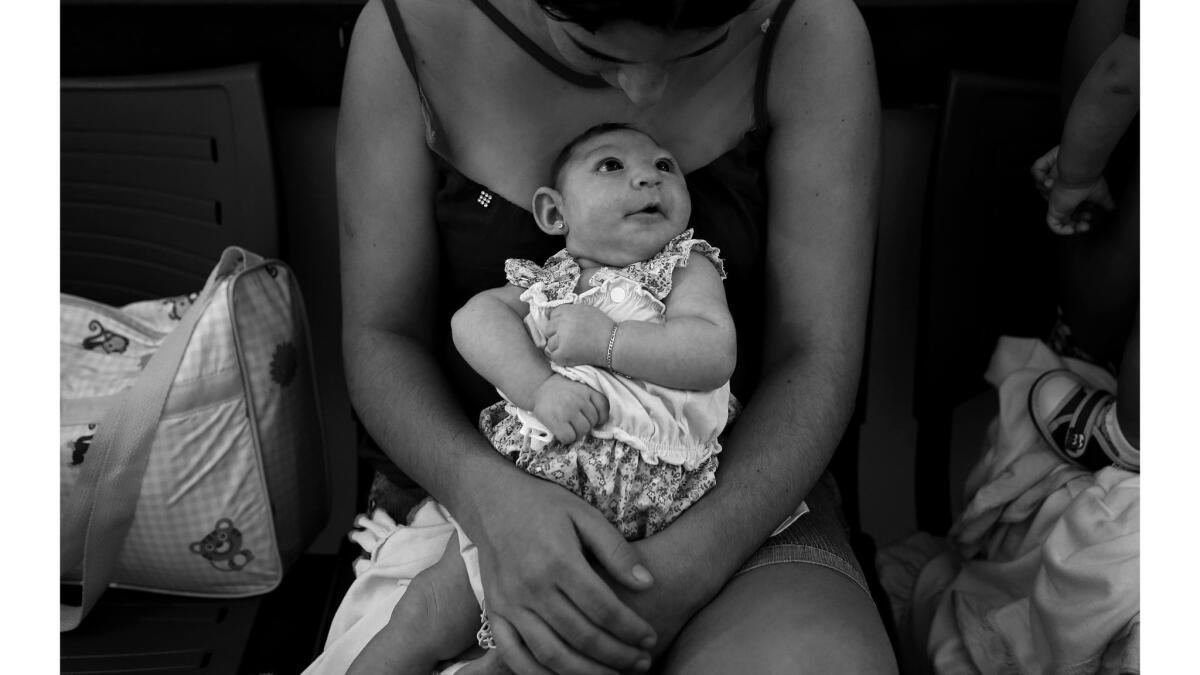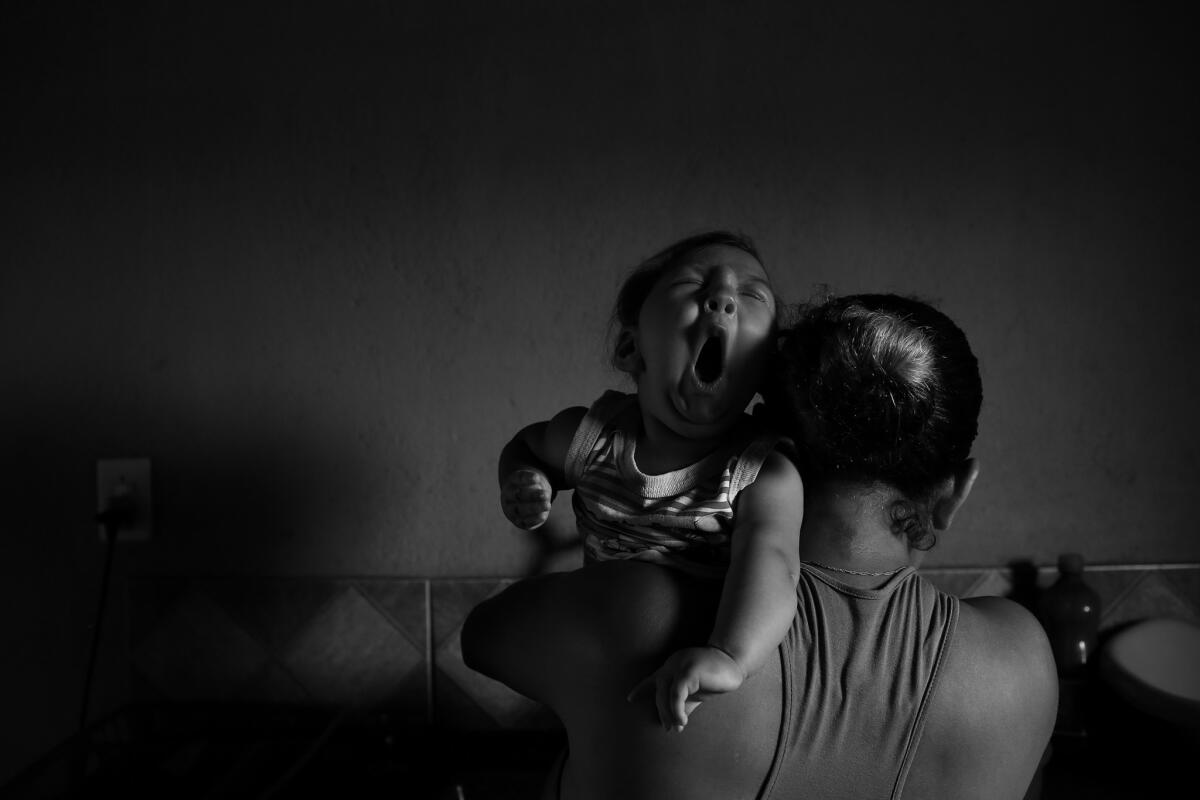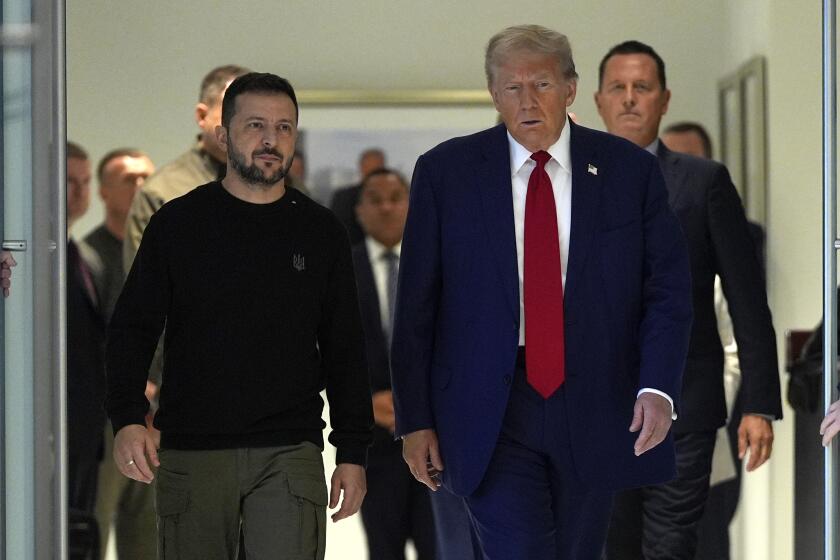Times photographer named Pulitzer finalist for Motherhood in the Time of Zika

In early 2016, northeast Brazil became the epicenter of the Zika epidemic, bringing enormous change to thousands of people’s lives. There was an unprecedented increase in cases of microcephaly, a condition in which babies are born with unusually small heads and often have associated brain damage.
There is a stigma associated with microcephaly in Brazil, and a prejudice against the disabled in general — some mothers had even been abandoned by their partners after their children were diagnosed with the birth defect. It was important to us to approach each person we talked to with sensitivity, and to make sure they knew that we would tell their story with dignity and respect.
The resulting work became an in-depth series which brought attention to an under-reported side of the Zika epidemic: the impact on rural communities in Brazil that are among the country’s poorest and most neglected. That struck a chord with readers, many of whom wrote to The Times to ask how they could help the families and the hospital that served them.

Juggling her tired son Gilberto, who was born with microcephaly, single mother Josemary Gomes, 34, cleans dishes at her kitchen sink, which does not have running water. Gilberto has to constantly be held or he will start crying again — babies with microcephaly in general tend to be more easily agitated than other infants and cry incessantly. Josemary’s days revolve around the 8-month-old boy, who is showing signs of developmental delays and has started having convulsions. She used to make a living as a cook and cleaner. “My only work now is taking care of Gilberto,” she says.
Josemary Gomes, age 34, reaches her hand out to one of her four sons, Jorge, age 4, as takes a rare moment to rest with Gilberto. Josemary was already raising four boys on her own when she met the man who would father Gilberto. She thought he would take care of them. But she says that when she got pregnant, he told her that he was already married. Josemary is among a growing number of women in Brazil who are raising children damaged by the Zika virus on their own. As many as a third of mothers are unmarried in this nation of 200 million, the hardest hit in an epidemic that has swept around the world. Studies suggest that the rate is highest in impoverished rural villages and crowded slums — the places most affected by the mosquito-borne virus that has been linked to at least 1,638 cases of birth defects across the country.
Samuel Amorim, age 2 months, who was born with microcephaly, is bathed by a family member in the kitchen of the family’s home in an impoverished neighborhood of Campina Grande, Brazil. Their neighborhood, which does not have running water for three days out of the week, is therefore infested with mosquitoes. Homes don't have screens on the doors or windows, and hardly anyone can afford bug spray. Last summer, when Alessandra de Sousa Amorim was pregnant with Samuel, she developed telltale symptoms of a Zika infection. When Samuel was born in December, scans showed damage to his brain.
Alexandre Santiago holds his son, Samuel Amorim, who was born with microcephaly, in their home in one of Campina Grande’s poorest neighborhoods. Before Samuel was born, Alexandre and his wife, Alessandra de Sousa Amorim, both worked outside of the home. But now, Alessandra no longer has time to work cleaning houses. She says it is very difficult to be able to rely on only one income for their household, especially since there are so many new expenses like transportation, medical exams for Samuel, and other things they need for a child with microcephaly. “But when we’re in need,” Alessandra says, “I have no courage to ask.”
The day Josemary Gomes brought Gilberto home from hospital, she laid him on her bed and wept. When there were no tears left, "I raised my head and carried on alone,” she said. Here, Josemary navigates her kitchen floor littered with the toys of two of her young sons, after returning from a full day of medical appointments for her youngest boy, Gilberto, who has microcephaly. Josemary was already raising four boys on her own when she met the man who would father Gilberto. She thought he would take care of them. But when she got pregnant, she said, he told her that he was already married. “I am Gilberto’s father now,” she says, “I am mother and father at the same time.”
Vivian Amorim, age 4, shrieks with laughter with one of her three sisters, Valeria, age 16, in the kitchen of their family’s home. Vivian and Valeria are one of four sisters, and recently got a fifth sibling, Samuel, who was born with microcephaly. “I don’t let the sadness take over us,” their mother, Alessandra de Sousa Amorim, says. “If we think like that — only negative thinking, we’d end up crazy! So I don’t get stressed, or get angry about life…about the world and everybody, I will not settle for that!” With four daughters, it was Alessandra’s dream to have a son. When she got pregnant with her fifth child last summer, and found out it was a boy during an ultrasound, she screamed with joy. It took her a moment to realize that the doctor was tearing up. The fetus had an unusually small head, a condition known as microcephaly that is one of the most visible defects caused by the Zika virus. When Samuel was born in December, scans showed damage to his brain. Despite the hardships that come with raising a baby with microcephaly, there is still a lot of joy in their home.
Maria Silva Floa, age 20, holds her baby, Maria Silva Alves, 2 months, who was born with microcephaly, as she waits for her daughter’s physiotherapy appointment at Pedro 1 Municipal Hospital in Campina Grande, Brazil. Maria, along with other mothers of children with microcephaly, bring their babies to physiotherapy appointments two times a week. The type of therapy is thought to help in the development of babies with microcephaly.
The wait is long for physiotherapy appointments for babies with microcephaly, so in the hallway outside of the therapy room, mothers gather and share coffee, cake and news about their babies. “We’ve become a family here,” one mother said. The hospital has become a refuge for families, a place where parents can find comfort and camaraderie amid all the uncertainty.
There is much that scientists still don’t know about Zika and microcephaly, such as how high is the risk? Is exposure more dangerous in certain trimesters? Are there other factors that increase the chances that Zika will cause birth defects? Because of this, the U.S. Centers for Disease Control and Prevention in February dispatched researchers to Brazil to help unravel the mystery. Here, Dr. Megumi Itoh, left, an epidemic intelligence officer with the U.S. Centers for Disease Control and Prevention (CDC), measures the head of 5-month-old Adrielly Rutino, as she is held by her mother. The information they collect will be part of a case-control study, examining the association between women who may have had Zika when they were pregnant, and microcephaly in babies. This child did not have microcephaly, and was used as a “control” case in the study. For each mother who had a baby with microcephaly in the study, the researchers wanted to enroll, as a control, three others whose babies were born at around the same time and in the same place but who did not have microcephaly.
Dr. Megumi Itoh, left, an epidemic intelligence officer with the U.S. Centers for Disease Control and Prevention (CDC), takes a photo of the back of the head of 5-month-old Adrielly Rutino, who does not have microcepahly and was used as a “control” in the study, as she is held by her mother, Maria Girdielly, age 17. Because there is so much that scientists still don’t know about Zika and microcephaly, the CDC dispatched researchers to Brazil to help unravel the mystery. They are collecting this data for a case-control study examining the association between women who may have had Zika when they were pregnant, and microcephaly in babies. For each mother who had a baby with microcephaly in the study, the researchers wanted to enroll, as a control, three others whose babies were born at around the same time and in the same place but who did not have microcephaly.
After receiving confirmation that her son has microcephaly, Francinelma Santos, age 29, holds Jhin Pirlo, 2 months, as she waits for a car to drive them home from the hospital. Because her son has a larger head than most babies with microcephaly, Francinelma was not sure if he had the neurological condition known as microcephaly. But during a neurologist consultation appointment with Dr. Alba Batista, it was confirmed. ”Is it really microcephaly?" Francinelma asked, "Yes," replied Dr. Batista. Dr. Batista said only time will tell if Jhin will have developmental problems in the future.
Kalissandra de Olivera, age 17, takes a nap next to her son in a hallway of Pedro 1 Municipal Hospital. Between medical exams, physiotherapy appointments, and support group meetings, parents of babies with microcephaly spend long hours — for several days each week — inside this hospital. Pedro 1 is one of Brazil’s first hospitals to open a microcephaly ward.
Claudenice Batista, who is eight months pregnant, waits for her appointment in the microcephaly wing of Pedro 1 Municipal Hospital, to go over the results of her ultrasound, showing whether or not her baby has microcephaly. Room 117 is where pregnant women come to learn the results of their ultrasound tests. Once, most just wanted to know: Is it a boy or a girl? These days, the first question they ask is: How big is the head?
Kalissandra de Olivera, age 17, rests on an exercise ball as her son, Nicolas Felipe Alves de Olivera, 3 months, receives physiotherapy at Pedro 1 Municipal Hospital. During her pregnancy, Kalissandra had a normal ultrasound, and didn't find out that her child had microcephaly until he was born. She had never even heard of the birth defect, and was told to come to Pedro 1 and they would explain. She started bringing Nicolas Felipe to physiotherapy when he was 17 days old. Her days are now packed with medical appointments and meetings.
In the six years that physiotherapist Jeime Leal worked at a pediatrician’s office, she never had a microcephaly case. When she started at Pedro I Municipal Hospital in December — when a wing of the hospital was created for patients with microcephaly due to the spike of cases in the region— there were seven cases at the hospital. She now sees twice that number in a single day. Here, Nicolas Felipe Alves De Olivera, 3 months, looks up at Jeime, during a physiotherapy session at Pedro 1 Municipal Hospital.
Evellyn Mendes Santos, age 9, kisses her baby sister, Heloyse, who was born with microcephaly, outside of their home in Joao Pessoa, Brazil. “My biggest dream was to have two girls,” their mother, Maria da Luz Mendes Santos, says.
Behind their home, Carla de Sousa, who is pregnant, left, and her mother, Maria de Sousa, listen as mosquito control agents give tips on how to prevent having mosquitoes around their home. An agent drew a sample of water being stored in a broken washing machine near their back door; it was full of writhing mosquito larvae. Agents pointed to other places where water had pooled, creating prime habitat for mosquitoes to lay its eggs: old cinderblocks, the dog’s water dish, even a discarded bottle cap. Before heading to the next house, one of the mosquito control agents urged Carla to get an ultrasound, to check that her fetus is developing normally.
After fumigating a neighborhood in an attempt to eradicate the mosquito that causes the Zika virus, a health worker with Campina Grande's Municipal Health Department, prepares to remove his gas mask. With no vaccine or treatment for Zika, Brazil’s government has few options besides sending teams to every infested region to hunt down and kill the insects that carry the virus, Aedes aegypti.
Alexandre Santiago hands his youngest daughter, Vivian, age 4, one of the family’s chickens, in the backyard of their home. Their family uses some of the chickens to be able to have eggs to eat. Alexandre is now the sole provider of the family’s house, as his wife, Alessandra de Sousa Amorim, no longer has time to work as a house cleaner because of the amount of extra time and care a baby with microcephaly involves. She says it is very difficult to be able to rely on only one income for their household, especially since there are so many new expenses like transportation, medical exams for Samuel, and other things they need for a child with microcephaly. “But when we’re in need,” Alessandra says, “I have no courage to ask.”
Only time will tell what the future is for these children born with microcephaly. At this early stage, the babies can do most of the things as others the same age, and there are varying degrees of the condition. But many children with microcephaly develop severe cognitive and physical disabilities and need expensive therapies, monitoring by specialists, and lifelong care. Some mothers at Pedro 1 Municipal Hospital, where Alessandra de Sousa Amorim, pictured here, takes her baby, have been arriving with questions for the neurosurgeon: Will their children ever learn to walk? Will they ever speak? Dr. Alba Batista, wishes she had answers. Who knows? “Only God,” she says. “Here, we are humans.”
READ THE SERIES
On the frontline of Brazil’s war with Zika, a mother’s first question: ‘How big is the head?’
Chasing an epidemic: On the road with Brazil's Zika detectives
When it comes to raising a child disabled by Zika, Brazilian women often do it alone
Brazil defeated the mosquito that spreads Zika once before — few expect it to do so again
Sign up for Essential California
The most important California stories and recommendations in your inbox every morning.
You may occasionally receive promotional content from the Los Angeles Times.








